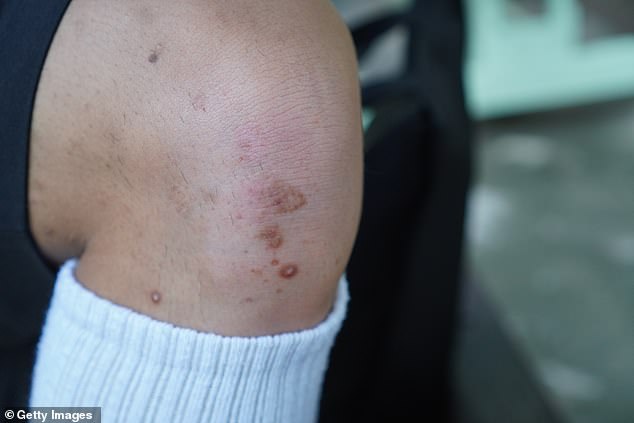I have been taking a blood pressure medication called ramipril for about a decade. Since the dosage was increased in 2019, I have developed some large, flat freckles on my shins that look like spots. Could this be due to the medication?
Dr. Ellie Cannon responds: New skin lesions should always be examined by your GP.
We look for worrying moles (those that have changed in color, shape or size), as these can be a sign of skin cancer.
But other types of skin changes can also be signs of a medical problem.
Many GP practices allow patients to submit photographs of skin lesions, which can then be sent to a dermatology specialist for review.
New skin lesions should always be examined by your GP, writes Dr Ellie Cannon
Brown discoloration on the legs is often referred to as hemosiderin deposition. This is something we see in the ankles and legs of patients whose blood vessels are not working as well as they should. This causes blood cells to leak out of the veins into the skin, hence the brown discoloration.
Hemosiderin deposition is often seen in patients with high blood pressure, so it is not surprising that someone taking ramipril would experience it, and it is unlikely to be caused by the drug itself.
It is a commonly used medication for high blood pressure.
A side effect is a skin reaction, but usually in the form of rashes or spots, not freckles.
Instead, it could be a sign that Ramipril is not doing enough to lower your blood pressure.
This is worrying because high blood pressure increases the risk of heart disease.
Other ways to address high blood pressure include exercise, a healthy low-salt diet, and not smoking or drinking alcohol.
Anyone concerned that the spots on their legs are getting worse should consider moving more, as well as elevating their legs when possible.
It would be worth speaking to a doctor or pharmacist to see if it would be safe to try a light compression stocking, as this can improve blood flow.

A skin reaction could be a sign that Ramipril is not doing enough to lower blood pressure, writes Dr. Ellie
I was recently told that I have recurrent bronchitis and will need to take antibiotics for a year. I’ve heard that antibiotics can cause muscle weakness, so should I be worried about long-term side effects?
Dr. Elie answers: Taking antibiotics for a long period of time can have side effects, but it is almost always in the patient’s best interest to do so.
Bronchitis is a medical term for a chest infection. When a patient has recurrent bronchitis, it means that they are fighting repeated infections that the body has difficulty clearing.
Long-term treatment with antibiotics can help eliminate bacterial chest infections and prevent new ones from developing.
Recurrent bronchitis should not be confused with chronic bronchitis, which is when the lungs remain inflamed even when there is no infection.
One of the most commonly used antibiotics for bronchitis is called azithromycin. Muscle weakness is not listed as a possible side effect, although joint pain has been reported in about one in ten users.
Taking antibiotics for a year can lead to intestinal problems, such as loss of appetite, pain and nausea. This is because the intestine is full of “beneficial” bacteria that can be altered by the use of an antibiotic.
However, when azithromycin is prescribed for recurrent bronchitis, it is usually given at a low dose compared to when people take it to fight a serious infection, so the risk of these side effects is much lower.
I am 79 years old and had my prostate removed about six years ago due to cancer. Since then I have had mild incontinence, but I have heard about a procedure called Bulkamid that might help. Could you help me?
Dr. Ellie answers: Bulkamid is a procedure that involves partially blocking the urethra (the tube through which urine leaves the bladder). This is done by three or four injections of gel (which are often uncomfortable) into the wall of the urethra.
Many women who have undergone Bulkamid report less leakage, meaning it is an excellent alternative to more invasive forms of incontinence treatment such as surgery or implant mesh.
But studies suggest it doesn’t work as well in men. The success rate is around 30 per cent and for this reason it is only offered to women through the NHS, although it can be done privately for men.
However, there are other options for incontinence. Some medications can combat the problem, such as oxybutynin, solifenacin and mirabegron, which are more useful if the bladder is overactive.
The NHS also offers bladder physiotherapy, which involves exercises to strengthen the muscles that control bladder outlet.
It is worth talking to a GP about how best to reduce leaks.

